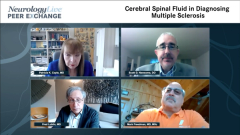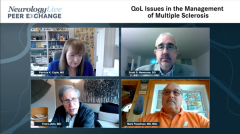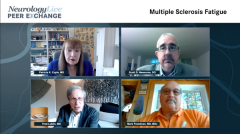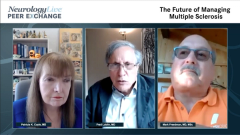
Cerebrospinal Fluid in Diagnosing Multiple Sclerosis
Episodes in this series

Discussion of testing for the presence of oligoclonal bands in cerebrospinal fluid to assist in the diagnosis of multiple sclerosis, as well as when to retest cerebrospinal fluid.
Fred Lublin, MD: Another interesting question is, when does CSF [cerebrospinal fluid] turn positive? We’re seeing people earlier and earlier, and that percentage changes over time between people who are clearly established vs people early on when we’re trying to diagnose them.
Patricia K. Coyle, MD: Oligoclonal bands represent plasma cells in the meninges, and they’re even being reported during the prodromal state, so it can occur pretty early. One big thing is that in MS [multiple sclerosis], they don’t go away. They shouldn’t disappear. They shouldn’t clear.
Fred Lublin, MD: You don’t need to repeat it for that reason.
Mark Freedman, MD, MSc: If it’s an early event and you look at the RIS [radiologically isolated syndrome] studies that are out there, many of these patients have already had spinal taps done for whatever reason, and they’re often positive. If you look at those who are positive, they’re more likely to turn into MS in the coming years. Those studies are accumulating data.
Scott D. Newsome, DO: Fred, you mentioned not repeating LPs [lumbar punctures] over time. I’m curious. Let’s say you do an LP and you don’t have the presence of oligoclonal bands or IgG index, but it has features of a demyelinating disease. Do any of you repeat that over time, especially if it’s a questionable case? Maybe you put them on a lower-potency therapy that potentially won’t offend or exacerbate another imitator? What are people doing?
Patricia K. Coyle, MD: I have done it both ways. I’ve repeated a spinal tap because they didn’t have bands to see if they appeared over time. I’ve also retapped because we were suspicious they might not have MS. I retapped to see if the bands had disappeared.
Fred Lublin, MD: You were thinking that the initial positive was incorrect?
Patricia K. Coyle, MD: MS is not the only thing that can cause CSF oligoclonal bands. You can see them in a myriad of chronic inflammatory infectious diseases, but they often disappear. That doesn’t happen in MS.
Mark Freedman, MD, MSc: They’ll disappear in ADEM [acute disseminated encephalomyelitis]. If they’re present in NMO [neuromyelitis optica]. It might be a very early phenomenon that will go away.
Scott D. Newsome, DO: In Lyme disease, they will also go away.
Fred Lublin, MD: This is useful. Have the McDonald criteria changed how you think about treating individuals?
Patricia K. Coyle, MD: No. You want to do a very convincing work-up, but if they have MS, you want to get them on treatment as quickly as possible.
Fred Lublin, MD: The McDonald criteria let you diagnose earlier, right?
Scott D. Newsome, DO: That’s what I was going say. They have allowed me to make the diagnosis sooner. They make me feel more comfortable that this is what we’re dealing with, vs the 9 T2 lesions and other things that you would have to consider when diagnosing MS using the older criteria. Given the specificity and sensitivity of the 2017 criteria, they have allowed me to say, “This is definitely MS; let’s get you on therapy,” vs, “Maybe we need to repeat the MRI in 3 months to see what happens or maybe do another lumbar puncture.” They have allowed me to make diagnoses.
Patricia K. Coyle, MD: Certainly, everyone would treat high-risk CIS [clinically isolated syndrome] as well. They don’t have to officially. If they’re high risk, you treat them, right?
Scott D. Newsome, DO: True. That is true, yes.
Fred Lublin, MD: But we have made it easier to diagnose. It is much easier to diagnose right now. The inverse of that is misdiagnosis, and the primary basis of misdiagnosis is people misinterpreting the MRI. Scott, you had commented on what the criteria were and where those lesions had to be. It doesn’t mean if you don’t have it there, you don’t have MS, but it’s because the criteria were developed based on that.
Scott D. Newsome, DO: For people who are doing this day in and day out—MS specialists or neuroimmunologists—it seems pretty straightforward. You mentioned high-risk CIS. There are plenty of data to support starting people on therapy with that sort of syndrome.
For general neurologists or people who are less familiar with MS, the McDonald criteria—at least the version now—make it a lot easier for the clinicians who are not specialists. That’s where they have their greatest utility, to be honest.
Newsletter
Keep your finger on the pulse of neurology—subscribe to NeurologyLive for expert interviews, new data, and breakthrough treatment updates.











































